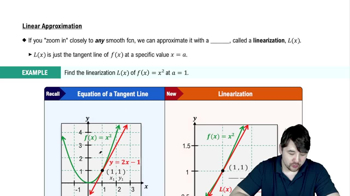Table of contents
- 0. Functions7h 52m
- Introduction to Functions16m
- Piecewise Functions10m
- Properties of Functions9m
- Common Functions1h 8m
- Transformations5m
- Combining Functions27m
- Exponent rules32m
- Exponential Functions28m
- Logarithmic Functions24m
- Properties of Logarithms34m
- Exponential & Logarithmic Equations35m
- Introduction to Trigonometric Functions38m
- Graphs of Trigonometric Functions44m
- Trigonometric Identities47m
- Inverse Trigonometric Functions48m
- 1. Limits and Continuity2h 2m
- 2. Intro to Derivatives1h 33m
- 3. Techniques of Differentiation3h 18m
- 4. Applications of Derivatives2h 38m
- 5. Graphical Applications of Derivatives6h 2m
- 6. Derivatives of Inverse, Exponential, & Logarithmic Functions2h 37m
- 7. Antiderivatives & Indefinite Integrals1h 26m
- 8. Definite Integrals4h 44m
- 9. Graphical Applications of Integrals2h 27m
- 10. Physics Applications of Integrals 2h 22m
4. Applications of Derivatives
Linearization
Problem 4.R.45
Textbook Question
45–46. Linear approximation
a. Find the linear approximation to f at the given point a.
b. Use your answer from part (a) to estimate the given function value. Does your approximation underestimate or overestimate the exact function value?
ƒ(x) = x²⸍³ ; a =27; ƒ(29)
 Verified step by step guidance
Verified step by step guidance1
To find the linear approximation of a function f(x) at a point a, we use the formula L(x) = f(a) + f'(a)(x - a). This is derived from the tangent line to the curve at x = a.
First, calculate f(a) for the given function f(x) = x^(2/3) at a = 27. This involves evaluating 27^(2/3).
Next, find the derivative f'(x) of the function f(x) = x^(2/3). Use the power rule for derivatives: if f(x) = x^n, then f'(x) = n*x^(n-1). Here, n = 2/3.
Evaluate the derivative at the point a = 27 to find f'(27). Substitute x = 27 into the derivative expression you found in the previous step.
Now, substitute f(a), f'(a), and a into the linear approximation formula L(x) = f(a) + f'(a)(x - a) to find the linear approximation L(x) at x = 29. Compare this approximation to the actual value of f(29) to determine if it is an underestimate or overestimate.
 Verified video answer for a similar problem:
Verified video answer for a similar problem:This video solution was recommended by our tutors as helpful for the problem above
Video duration:
6mPlay a video:
Was this helpful?
Key Concepts
Here are the essential concepts you must grasp in order to answer the question correctly.
Linear Approximation
Linear approximation is a method used to estimate the value of a function near a given point using the tangent line at that point. It is based on the idea that a function can be closely approximated by a linear function (a straight line) when the input values are near a specific point. The formula for linear approximation is f(x) ≈ f(a) + f'(a)(x - a), where f'(a) is the derivative of the function at point a.
Recommended video:

Linearization
Derivative
The derivative of a function at a point measures the rate at which the function's value changes as its input changes. It is a fundamental concept in calculus that provides information about the slope of the tangent line to the function at that point. In the context of linear approximation, the derivative is crucial because it determines the slope of the tangent line, which is used to create the linear approximation.
Recommended video:

Derivatives
Estimation and Error Analysis
Estimation in calculus involves using methods like linear approximation to predict the value of a function without calculating it exactly. After estimating, it is important to analyze whether the approximation underestimates or overestimates the actual function value. This can be determined by examining the concavity of the function or the behavior of the derivative, which helps in understanding the accuracy of the approximation.
Recommended video:

Determining Error and Relative Error
Related Videos
Related Practice



